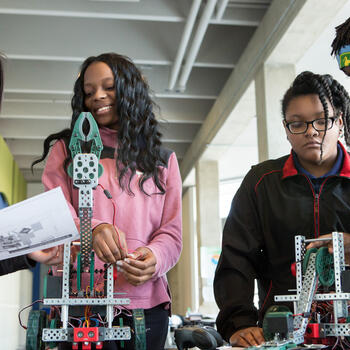By Moises Martinez- September 20, 2022
A core memory for me during the start of the pandemic was my chemistry teacher’s first lecture. She shared her screen over Zoom, and the whole class saw her YouTube recommended list. Titles ranging from “How to Look Confident on Zoom” to “Top 10 Hidden Features on Zoom” flashed on the screen. In that instant, I realized I wasn’t alone; students and teachers alike had to work through difficult challenges of being remote. Coming back to in-person school is going to be challenging for many students. In fact, the state of Illinois revised its Illinois Children’s Mental Health Plan (ICMHP) in May of 2022 in response to the COVID-19 pandemic’s effect on the mental well-being of children.
In my experience, the COVID-19 pandemic has caused a gap in incoming high school students’ maturity levels because of the fewer social interactions students were involved in. I found freshman year to be a crucial maturing point for me and my classmates. Leaving eighth grade, we are used to being the oldest and most mature students, but, in high school, suddenly, we are back at the bottom and have to interact with upperclassmen who serve as role models, or not. To my mind, remote schooling over the last few years has removed these necessary interactions. Last year, at the beginning of the year, underclassmen would yell in the hallways during class periods for no other reason than they could. Upperclassmen are also showing signs of poor social maturity. At my school, a group of seniors put dead fish in the boys bathroom toilets!
My own freshman year was cut short with the breakout of the epidemic and the rapid transition to remote learning. With my sophomore year entirely virtual, I know the difficulty I had interacting with anyone outside of my online class. It wasn’t until my junior year that I stepped foot back into my school. Suddenly, in the blink of an eye, I went from a freshman to a junior. Losing these necessary years of development has caused many problems in high schools where now the juniors and seniors are as socially and emotionally stunted as freshmen and sophomores.
Last school year, the freshman class hadn’t had a normal school year since the beginning of seventh grade. Half way through that year, everything changed for them. At my school, the impact of this was the behavior of freshmen was wildly different than any class before them. Aside from acting immature, students in the freshman class exhibited less inclusive behaviors, and the number of bullying incidents went up. The effects of online learning are going to be felt this upcoming year as new freshmen come into high school missing crucial developmental years from middle school. The junior class this year will be made up of students who have only physically been in high school for 1 year—and this class is expected to be a role model for incoming classes.
The state of Illinois revised its ICMHP as a result of this worsening crisis. One major step in developing this plan was asking students what they felt were main issues for children’s mental health in Illinois. The ICMHP group asked nearly 150 students all from different parts of Illinois this question, gathering participants by using connections to the Illinois State Board of Education, Department of Juvenile Justice, and Department of Children and Family Services. The response to this question was interesting, in that 11% of youths felt that isolation was a main issue, and other responses included stigma around mental health, lack of family involvement, increased stress and emotional concerns, and not feeling empowered or knowledgeable to address issues (ICMHP, Figure 7). The isolation was then described as a result of schools closing due to the COVID-19 pandemic shutting down interactions with family members, peers, and other adults.
I feel my school has done a great job with trying to solve the problem by giving students copious opportunities to socialize outside the classroom. Hersey High School offers tons of different clubs that go beyond the standard extracurricular activities. Recently, new clubs have been sprouting up where students can find others who enjoy the same interests as them, such as hacker club where you can learn about computer programming, app development, and various other computer-based skills. There’s also an anime club, Non-Fungible Token (NFT) club, empower me club, and various other cultural groups. These new clubs are crucial for helping students find friends outside of their classes.
Hersey High School has also fostered a sense of community between students, by having peer tutors available all periods of the day in the academic resource center so that students can seek help from others who have taken the class and can offer advice from past experiences. This system works great because some high school students are shy when it comes to getting help from adults, and, when it’s a fellow peer, there is a certain level of understanding that might not be there with an adult. Both of these methods are great ways to get students academic help and build smaller communities and friend groups inside the school, all with the hopes of improving student relations and making the atmosphere of the school better.
To conclude, I hope other school districts follow these suggestions because they have greatly helped my school recover from lingering effects of the COVID-19 pandemic. I envision a future where high school students can safely come together, turning a school into a community.
Moises Martinez is a high school student at Hersey High School. He is also involved in numerous extracurricular activities including the Golf Team.
Photo by Allison Shelley/The Verbatim Agency for EDUimages.
